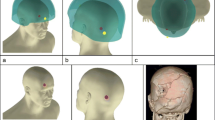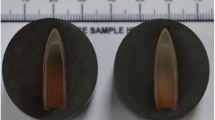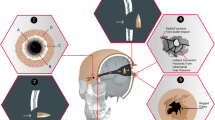Abstract
Reports on penetrating ballistic head injuries in the literature are dominated by case studies of suicides; the penetrating ammunition usually being .22 rimfire or shotgun. The dominating cause of injuries in modern warfare is fragmentation and hence, this is the primary threat that military helmets protect the brain from. When helmets are perforated, this is usually by bullets. In combat, 20 % of penetrating injuries occur to the head and its wounding accounts for 50 % of combat deaths. A number of head simulants are described in the academic literature, in ballistic test methods for helmets (including measurement of behind helmet blunt trauma, BHBT) and in the ‘open’ and ‘closed’ government literature of several nations. The majority of these models are not anatomically correct and are not assessed with high-velocity rifle ammunition. In this article, an anatomically correct ‘skull’ (manufactured from polyurethane) and ‘brain’ (manufactured from 10 %, by mass, gelatine) model for use in military wound ballistic studies is described. Filling the cranium completely with gelatine resulted in a similar ‘skull’ fracture pattern as an anatomically correct ‘brain’ combined with a representation of cerebrospinal fluid. In particular, posterior cranial fossa and occipital fractures and brain ejection were observed. This pattern of injury compared favourably to reported case studies of actual incidents in the literature.



Similar content being viewed by others
Notes
ARRK Europe, Gloucester Technical Centre Olympus Park, Quedgeley, Gloucester, Gloucestershire, GL2 4NF, UK.
References
Karger B (1995) Penetrating gunshots to the head and lack of immediate incapacitation I. Wound ballistics and mechanisms of incapacitaton. Int J Legal Med 108:53–61
Fenton TW, Stefan VH, Wood LA, Sauer NJ (2005) Symmetrical fracturing of the skull from midline contact gunshot wounds: reconstruction of individual death histories from skeletonized human remains. J Forensic Sci 50(2):1–12
Thali MJ, Kneubuehl BP, Zollinger U, Dirnhofer R (2002) The skin–skull–brain model: a new instrument for the study of gunshot effects. Forensic Sci Int 125:178–189
Lieske K, Janssen W, Kulle K-J (1991) Intensive gunshot residues at the exit wound: and examination using a head model. Int J Legal Med 104:235–238
Kieser DC, Carr DJ, Girvan L, Leclair SCJ, Horsfall I, Theis J-C, Swain MV JAK (2013) Identifying the source of bullet wipe—a randomised blind trial. Int J Legal Med. doi:10.1007/s00414-013-0874-z
Baxter D, Wilson M (2012) The fundamentals of head injury. Neurosurgery 30(3):116–121
Hardman JM, Manoukian A (2002) Pathology of head trauma. Neuroimaging Clin N Am 12(2):175–187, vii
Chitnavis JP, Gibbons CLMH, Hirigoyen M, Lloyd Parry J, Simpson AHRW (1996) Accidents with horses: what has changed in 20 years? Injury. Int J Care Injur 27(2):103–105
Macnab AJ, Smith T, Gagnon FA, Macnab M (2002) Effect of helmet wear on the incidence of head/face and cervical spine injuries in young skiers and snowboarders. Injur Prev 8(4):324–327
Siu TLT, Chandran KN, Newcombe RL, Fuller JW, Pik JHT (2004) Snow sports related head and spinal injuries: an eight-year survey from the neurotrauma centre for the Snowy Mountains, Australia. J Clin Neurosci 11(3):236–242
Jones SJ, Lyons RA, Evans R, Newcombe RG, Nash P, McCabe M, Palmer SR (2004) Effectiveness of rugby headgear in preventing soft tissue injuries to the head: a case–control and video cohort study. Br J Sports Med 38(2):159–162
Bond GR, Christoph RA, Rodgers BM (1995) Pediatric equestrian injuries: assessing the impact of helmet use. Pediatrics 95(4):487–489
Lim J, Puttaswamy V, Gizzi M, Christie L, Croker W, Crowe P (2003) Pattern of equestrian injuries presenting to a Sydney teaching hospital. Aust N Z J Surg 73(8):567–571
McCrory P (2002) The role of helmets in skiing and snowboarding. Br J Sports Med 36(5):314
Carey ME (1987) Learning from traditional combat mortality and morbidity data used in the evaluation of combat medical care. Mil Med 152(1):6–13
Breeze J, Gibbons AJ, Shieff C, Banfield G, Bryant DG, Midwinter MJ (2011) Combat-related craniofacial and cervical injuries: a 5-year review from the British military. J Trauma Injur Infect Crit Care 71(1):108–113
Spalding TJW, Stewart MPM, Tulloch DN, Stephens KM (1991) Penetrating missile injuries in the Gulf war 1991. Br J Surg 78:1102–1104
Eskridge SL, Macera CA, Galarneau MR, Holbrrok TL, Woodruff SI, MacGregor AJ, Morton D, Sahaffer RA (2012) Injuries from combat explosions in Iraq: injury type, location, and severity. Injury 43(1678–1682)
Lewis EA Between Iraq and a hard plate: recent developments in UK military personal armour. In: IPAC (ed) Personal Armour Systems Symposium 2006 (PASS2006), The Royal Armouries, Leeds, UK, 18–22 September 2006
Schyma C, Greschus S, Urbach H, Madea B (2012) Combined radio-colour contrast in the examination of ballistic head models. Int J Legal Med 126:607–613
Sturdivan LM, Bexon R (1981) A mathematical model of the probability of perforation of the human skull by a ballistic projectile. Chemical Systems Laboratory, Aberdeen Proving Ground, Maryland
Watkins FP, Pearce BP, Stainer MC (1988) Physical effects of the penetration of head simulants by steel spheres. J Trauma 28(1 Supplement):S40–S54
Betz P, Steiefel D, Hausmann R, Eisenmenger W (1997) Fractures at the base of the skull in gunshots to the head. Forensic Sci Int 86:155–161
Hejna P, Safr M, Zatopkova L (2011) Reconstruction of devastating head injuries: a useful method in forensic pathology. Int J Legal Med 125:587–590
Barber TW, Brockway JA, Higgins LS (1970) The density of tissues in and about the head. Acta Neurol Scand 46(1):85–92
Jussila J (2004) Preparing ballistic gelatine—review and proposal for a standard method. Forensic Sci Int 141:91–98
Mabbott A, Carr DJ, Champion S, Malbon C, C T Comparison of 10 % gelatine, 20 % gelatine and Perma-Gel for ballistic testing. In: International Symposium on Ballistics, Freiberg, Germany, 22–26 April 2013
Acknowledgments
A-CL acknowledges an equipment grant from the Royal Swedish Academy of Sciences. Miss E. Girvan (Otago Centre for Electron Microscopy) assisted with the EDS analysis. This work was internally funded by The Impact and Armour Group at Cranfield University.
Author information
Authors and Affiliations
Corresponding author
Rights and permissions
About this article
Cite this article
Carr, D., Lindstrom, AC., Jareborg, A. et al. Development of a skull/brain model for military wound ballistics studies. Int J Legal Med 129, 505–510 (2015). https://doi.org/10.1007/s00414-014-1073-2
Received:
Accepted:
Published:
Issue Date:
DOI: https://doi.org/10.1007/s00414-014-1073-2




